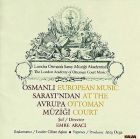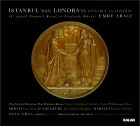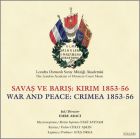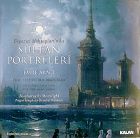Buy or gift a stand-alone digital subscription and get unlimited access to dozens of back issues for just £18.99 / $18.99 a year.
Please register at www.exacteditions.com/digital/cornucopia with your subscriber account number or contact subscriptions@cornucopia.net
Buy a digital subscription Go to the Digital EditionWhen Cornucopia sent Ateş Orga to cover the Istanbul Music festival, it was no routine assignment. It was a chance for him to retrace the footsteps of his father, the writer Irfan Orga.
I left Istanbul for London on December 27, 1947, at the age of four, a winter moon on solstice rise. I returned fifty-three years later, a summer sun at solstice rest. I cannot remember much of that childhood flight. But going back, crossing the Rumelian lands of my father’s maternal forebears, swinging out over the Black Sea before banking to sweep in low over ochrous, pantiled houses and heat-baked concrete strips, then out again, this time across the Marmara, before folding back for the approach to the marble and stainless steel splendours of the new Atatürk Airport, was a cocktail of high-adrenaline emotions. Here was a city and its place names I had always known – yet never known.
Within an hour of landing, I’m at the Atatürk Cultural Centre listening to a thirty-year retrospective from the Philip Glass Ensemble – a slickly rehearsed fest, breathtakingly attacked, instantly awakening. It jolts me into why I am here: to cover the 28th International Istanbul Music Festival.
The following humid, cloudless morning I awake to two facts of Istanbul life. The extraordinary seasonal turquoise that illuminates the Bosphorus from within. And the notion that reproduction equates with restoration. The truly old exists, of course, often poignantly beautiful. But so equally does a great deal of film-set façade. The yalis, the ornate, late nineteenth-century Ottoman houses that crowd the banks of the Bosphorus, may look picturesque, but I soon discover many of them to be fake – concrete-framed affairs, plastic-clad rather than timber-boarded, with insulated glazing rather than original windows and pre-cast mouldings in place of carved detail. In a city so many times ravaged by fire, what wooden buildings survive are all too often raggedly inhabited or forlornly dilapidated, some leaning at precarious angles, some sinking towards the water, their structures bared to the frame, every corner a mossy shelter to wraith-like prides of stray cats.
Remnants of village charm characterise Beylerbeyi, where I am staying – private flower gardens and fountains, shady trees, the fragrant smoke from a wood-burning hamam, an old floodlit mosque, fish restaurants, as well as noisy diesel engines and cracked pavements.
On May 15, 1919 a small boy sailed past this point on the ferry from Galata to Cengelkoy, bound for Kuleli, the long, grandly proportioned military school of the Ottomans. He was my father. Once landed, he and his mother and younger brother walked “the sea-road, tree-lined and white in the noonday sun. The school loomed up on our right, like a Palace, I thought, so white was it against the cloudless summer sky”. I trace his steps. Not as quiet now as then, but the hour as hot, dusty and bright as he would have remembered, gaily painted rowing boats tethered to the shore, young and old alike fishing their silver quarry.
Suddenly Kuleli is upon me, more massive close to than from the water, dominated by its Teutonic twin towers, its grey stone steps and great door, its guards beating their watch, its resonant symbols of empire and republic – the green-and-gold swirl of the sultan’s tugra, and the crescent-and-star of the national flag. I find it a forbidding place.
How intimidated and cut-off from his home in Beyazit my father must have felt, how far from the imperial mosque where he would pray on Fridays within sight of the last caliph. My eyes roam to the verdant hill behind. Here, as he grew older, my father would climb to a favourite tree to gaze upon the realms he might one day have to defend – up to the Black Sea, across to Bebek “in all its shimmering morning beauty”, down to Dolmabahce, “white and artificial as a wedding cake”. This was his Istanbul, “jewel of the Bosphorus. Grey it would look from this hill, and the smoke from the boats would lie over it like a soft veil, and tall and tapering are the minarets that enchant the skyline”. He told me about it often
That afternoon, taking the ferry from Uskudar to Besiktas, watching Leander’s Tower and the domed, long-fingered mosques of the Old City and Golden Horn coalesce out of the haze, I head for Aya Sofya, Justinian’s impassive altar to Christendom.
In an adjoining leafy garden, English tea with the violinist Cihat Askin and friends is taken to the unsynchronised antiphony of amplified muezzins calling the faithful to prayer. Nearby is Sultan Ahmet’s imposing Blue Mosque with its six assertive minarets. Down the hill, “a big wooden house, painted white with green shutters and trellised balconies overlooking the Marmara” is where my father passed his childhood.
That evening there’s a concert within the Topkapi grounds, in the echoing space of the Byzantine basilica of Aya Irini, the “Church of Divine Peace”. This is a magnificent survivor from antiquity, dominated as much by its stone floors, vaulted windows and bare walls as by its spotlit cross of black tesseræ stretching domewards.
Under the elegant and inspirational direction of Gürer Aykal, the Borusan Istanbul Philharmonic is the Turkish orchestra to watch these days, its strength and unjaded enthusiasm a tonic to ears tired by the complacency so often encountered west of Vienna.
Strengthened with members from Aykal’s American orchestra, the El Paso Symphony – and with two exceptional soloists in Kishna Davis and the theatrically outrageous Lawrence Craig – their way with Gershwin’s Porgy and Bess and Dvorak’s New World Symphony could not be more natural and idiomatic.
The Turks have always been famous for their hospitality. Minutes after the concert ends, I’m being urged to join the orchestra on their tour south. I go with them as far as Ephesus, crossing the Marmara by sea-bus to Bandirma before setting out by coach to Izmir.
Stone-baked, tinder-grassed Ephesus – unassuming and scarcely visible from the parched roadside, powerful and astral-charged within – is the closest I come this trip to the tourist trail. While our guide goes quaintly through her routine, I make my own acquaintance with the rooms and homes that stood here, with the ghosts who perchance still wander the ruins when the visitors are gone. This Saturday of apricot sunset, though, they have to wait. First for the concert in the amphitheatre, an open-air presentation of the 14th International Izmir Festival. Lawrence Craig’s impromptu use of every ancient stone as a theatrical prop sets the press cameras flashing, the Dvorak cor anglais solo touched greatness to the accompaniment of cicadas, and an old dog from the bush padded the tiers, caring for neither minister nor millionaire. Then for a candle-lit reception in the colonnaded remains of the Library, the heat of the night a backcloth to pulse-quickening folk dances, to flirtatious, intoxicated exchanges, to aching romance within the shadows. Then for our long walk out of history down the Marble Way, torch-lit beneath the stars, and back to air-conditioned modernity.
In Istanbul, my second week sees a friend from Cambridge, the composer-musicologist Emre Araci, arrive to keep me company. In seventy-two hours we accomplish much. Taking a boat up the Bosphorus, we land at Sariyer, formerly the summer refuge of the Ottoman elite, where as a boy my father would go to his uncle’s yali, with its rose-scented rooms, its magnolia gardens and greenhouses, its grapevines and orchard. As a young Air Force officer he went back, but by then it was tumbled down, “vanished like its long-dead owners”, its garden “choked with weeds”. We have less luck, able only to imagine. But we do find the dark, balconied, curvaceously carved, weatherboarded house that had once belonged to Emre’s family, now padlocked and up for sale, in a bad state of repair.
The following day we take a very different journey, across the Bosphorus, then east through Izmit to Karamürsel on one of the long blue inlets of the Marmara. This is last year’s earthquake country. Everyway there is devastation – broken houses, cracked walls no more than a brick wide, mound upon mound of rubble, dangerously tottering apartment blocks leering like sightless corpses. No one can sell their property, and the locals tell us that buildings aren’t being demolished because the authorities are waiting for the next earthquake to finish off the job. Yet old men sit around talking politics, smoking, and drinking tea from delicate glasses. Tanned, short-cropped, barefoot boys play in the dust. Everywhere satellite dishes sprout from unlikely corners. Maybe the taller buildings are no longer habitable, but their ground floors are home to ramshackle open-front shops. Fruit sellers water their produce to keep it fresh.
Karamürsel is where Aunt Bedia and Cousin Oya live. I cannot recall ever having met them – though they assure me I have. We communicate falteringly, silently. Effectively we’re strangers known to each other only through dated, faded images. Yet they open their house and arms to me. Here are the foods and smells of my childhood. Photographs from when we were young. A shrine to my father’s books. The telegram I sent thirty years ago telling of his death. Carefully pressed memorabilia of other times, another land. We touch, we sense, we drink the moment. The evening bus comes. My aunt gazes after me, matriarchally impassive but her eyes piercing deep, wanting perhaps to see something again of the men into whose family she had married. My cousin busies herself. Her niece and nephew come to say their goodbyes, pictures of eau-de-cologne grace and modesty. As we pull away I look back, lingering to remember better this spot where the earth gasps and the sea comes so lazily to kiss.
Following the path into my past, Emre and I spend an afternoon beyond the old Byzantine city walls, in the Merkezefendi graveyard, a forgotten expanse of cool stillness and smoky sun-beamed shadows. We come across Halide Edip’s grave, shamefully neglected and uncelebrated for so famous a mistress of letters. We stumble upon a rusting, long-ruined mausoleum to a dervish cook. We see with disbelief the small, roughly chiselled rock marking the resting place of the painter Ibrahim Çalli. Suddenly she’s there. Sevkiye Orga, my grandmother, 1895–1940: even shorter-lived, it seems, than my father remembered.
The rose trees he and his brother planted have gone, the marble headstone is dull, everywhere is a brittle tangle of overgrown weeds. Tidying what I can, I stoop to her memory. Then, following her sons before us, “with the sun and the kindly rain and the eternal nights to come”, we leave her to her sleep.
The Istanbul Festival climaxes with the stunning spectacle of Matthew Bourne’s gender-controversial Swan Lake, part of this year’s programme, which included the King’s Consort, Kiri Te Kanawa and Nigel Kennedy.
Turkish music was variously represented – from the classical vocalist Meral Ugurlu and the period-instrument Bezmârâ Ensemble, through contemporary song (Mesut Iktu), to the world premiere of Kudsi Ergüner’s Nazim Hikmet: Of Life and Death.
Ugurlu’s phrasing, elegance and artistry were unmistakable – but the Turkish weakness for indiscriminate amplification made for an unmusical balance, the voice too much to the fore, the inherant intimacy of the instruments lost.
So to my final Saturday, with the soprano Yelda Kodalli for morning coffee and patisseries à la parisienne in the Pera Palas Hotel – not much reproduction here, just immoderate Orient Express ornament, Art Nouveau wrought-iron, and an overwhelming turquoise-domed ballroom. I ask to try out the pianos, but no one can find the keys to unlock them.
My plane back to London is on Monday at sunrise. There is time still to watch the traffic on the Bosphorus, and time to ponder a society of contrasts and paradoxes. Time to recall a landscape where mountains are sliced in half for their marble, where advertising hoardings savage the forest harmony, where flags affirm and reaffirm the national psyche. Time to relive that first recognition of Kuleli in the distance of the night, and to remember good companionship by the waters of Beylerbeyi.
To save its fine architecture, a volcanologist has come up with a plan: to turn Kula into an elegant spa town by tapping its plentiful thermal springs. By Roger Williams. Photographs by Jean Marie del Moral and Roger Williams
Three köftes still stand out in my memory. Just thinking of them makes my taste buds ache. The first was in my early childhood: freshly grilled cizbiz kofte, a round patty the size of a flattened walnut, so named because it makes a delicious ‘jiz-biz’ sizzling sound as it cooks…
More cookery features
High in the Toros Mountains, Chris Gardener finds the remote Kasnak Forest carpeted with peonies in spring. Photographs by Kate Clow
The Russian artist Ivan Aivazovsky may have been derided by the avant-garde, but his dreamy seascapes and atmospheric panoramas won him patrons in high places. Ivan Samarine rediscovers a 19th-century virtuoso
Visitors to 1830s Istanbul were astonished to hear the strains of Rossini and Donizetti performed by Ottoman bands. As Emre Aracı reveals, Western music was the passion of Mahmud II
The world’s grandest chalet was built by Abdülhamid II for the visit of Kaiser Wilhelm II in 1889 and was a powerhouse of political activity in the final years of the empire. Today the house in the grounds of Yıldız Palace, on a hill in Istanbul, is all but forgotten. Philip Mansel treads softly through its silent halls. Photographs by Fritz von der Schulenburg

The London Academy of Ottoman Court Music, with Emre Aracı. Produced by Ates Orga,

Prague Symphony Orchestra, directed by Emre Aracı, produced by Ateş Orga

The London Academy of Ottoman Court Music, with Emre Araci

The Prague Symphony Chamber Orchestra with Cihat Askin, violin. Directed by Emre Araci and produced by Ateş Orga

Cornucopia works in partnership with the digital publishing platform Exact Editions to offer individual and institutional subscribers unlimited access to a searchable archive of fascinating back issues and every newly published issue. The digital edition of Cornucopia is available cross-platform on web, iOS and Android and offers a comprehensive search function, allowing the title’s cultural content to be delved into at the touch of a button.
Digital Subscription: £18.99 / $18.99 (1 year)
Subscribe now